Tony P. of San Juan Island WA is cutting new culinary trails with Chicaoji
- Peanut butter
- Avocado
- Cheese
- Tomato
- Chicaoji

Tony P. of San Juan Island WA is cutting new culinary trails with Chicaoji

This recipe is extremely flexible. Basically, it’s about pan roasting whatever you want to eat, steaming some greens on top of it and then eating this with Chicaoji Sauce & plain yogurt. The quantity of food depends on how many people you are feeding and how big a skillet/pan you have.
Here’s a recipe for Salmon Tagine from Jon P. over in Texas.
“Coat salmon generously with Chicaoji and let marinate for 30-60 mins. Do this on the counter to let the fish come to room temp, but if you go longer than 30 mins you might want to do it in the fridge for the first while and then take it out.
Ingredients:
Into stovetop tagine,
Megan from Lopez Island shared this recipe and I’ve quoted her below:
“So the original recipe I found online but used different ingredients of course so I changed it and ran with the change bc I loved it sooooo much!!! so I can only take credit for my version of it but yes you may use my name if you would like, thank you for asking.
I call it
Chicaoji Cream Sauce
I know that all sounds soo odd together but it’s amazing. I make a full jar of it anytime I make it so I double if not more that recipe. Also, I don’t measure it out anymore. But it’s easy to tweak if you like it spicer or sweeter or more tang just adjust each portion as the individual prefers.
Hope that all makes sense.
I use it on veggies (both as a dip or drizzle), on salmon (plain or teriyaki), on chicken, in wraps or sandwiches, on my egg breakfast sandwiches or burritos. I just love it on everything!!!!
Hope you enjoy it!!! I’d love to hear what you think if you try it.”
I shared Megan’s recipe in the Chicaoji Newsletter so she received her free 12 oz bottle of Chicaoji.
Maple syrup provides the sweetness to balance the tart apple cider vinegar. I decided to make Maple Chicaoji Sauce because many people prefer maple syrup to agave syrup.
I use Maple Valley Cooperative maple syrup. You may not be able to detect a flavor difference between maple and agave versions because the goji berries, cacao, and smoky chipotles dominate the flavor and aroma.
Here’s link to the Chicaoji order page.
A devoted chocolate lover will always be sure to tell you about the health benefits of their favorite sweet treat. “It’s full of antioxidants, it’s good for your heart and it prevents cognitive decline,” one will say while shoveling down a box of chocolate truffles. Like lovers of red wine, chocolate addicts have a myriad of scientific studies to back up their claims, the collection of research into cacao suspiciously disproportionate to less delicious foods.
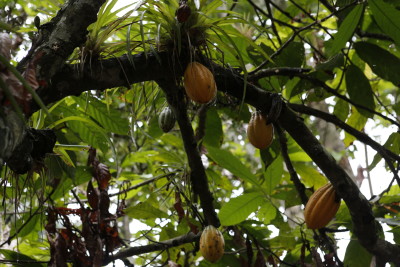
Chocolate lovers are right, in a way. At the heart of every bar of chocolate there indeed lies an ingredient with many proven health benefits. The problem is, the cacao bean is usually so overwhelmed by the milk, sugar and other ingredients that are added to chocolate that it has little room left to do its good work in your body. Knowing this, many people wisely opt for dark chocolate because it has more cacao beans and less milk and sugar.

Chicaoji takes cacao bean purity a step further by using the raw cacao and nothing else. The cacao ‘nibs’ in Chicaoji are cacao beans that have been broken into smaller pieces. These nibs taste somewhat bitter on their own, but when they are blended with sweet agave nectar, they impart a flavor that chocolate lovers will recognize well. Using raw cacao beans in Chicaoji allows us to share some of the nutrient dense compounds in cacao that have fueled chocolate’s good reputation.
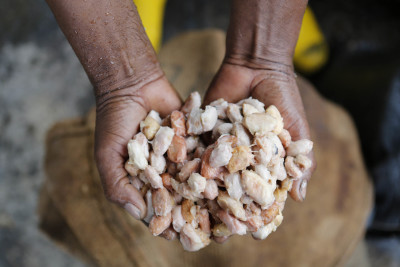
Here are a few of the reasons we use raw cacao:
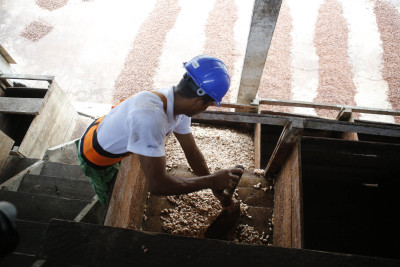

P.S.
I want to thank Alia O’Connell for helping me compose this blog article. I very much enjoy her style of writing. She does a great job of ordering my jumbled thoughts and ideas. I made only a couple of edits for emphasis. Alia is available to help you with your needs for well-composed English.
Alia O’Connell ~ aliaoconnell@nullyahoo.com
Photo credits go to Pacari. I used images from their website for this post.
If you know that food is medicine, then you understand Chicaoji.
Thank you for reading the Chicaoji blog!
Randall
Loaded with a full spectrum of flavors, Chicaoji can satisfy any type of food craving that you may have be it spicy, salty, tangy or sweet. If you’re looking to delight your sweet tooth without making it ache, the subtle sweetness of Chicaoji won’t disappoint. Chicaoji’s sweet spot is derived from agave nectar, a natural sweetener that is made from the blue agave plant of central Mexico.
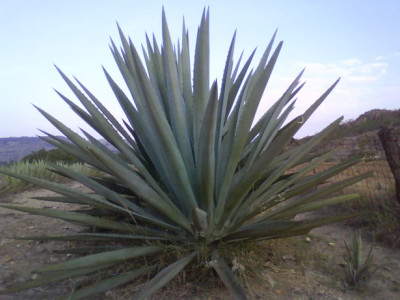
Agave nectar is a rather new type of sweetener that has gained a lot of popularity thanks to public demand for sugar alternatives. In the late 1990s, agave farmers who would have otherwise used the green desert plant to make tequila began manufacturing sweet agave nectar from the plant’s core. Though modern agave nectar is more syrup-like, the native Aztecs have been flavoring their foods with sweet “honey water” obtained from the agave plant for thousands of years.
In a market teeming with alternative sweeteners, agave nectar has stood out in the crowd for a number of reasons. First, agave nectar has a fantastic and complex flavor that does a lot more than just provide a hint of sweetness. Because agave nectar is slightly sweeter than sugar, you don’t have to use as much of it in your morning tea, coffee or smoothie. With a consistency that is silkier than honey, agave nectar blends easily into sauces, stir-fries and salad dressings.
While agave nectar is highly regarded for its rich but subtle flavor, the sweetener is also valued for its low glycemic index. People who are diabetic or overweight choose agave nectar to sweeten their foods because it has low levels of glucose and measures a relatively low score of 32 on the glycemic index. In fact, agave nectar has a lower glycemic index than honey, another popular natural sweetener.
Another reason agave nectar is a superior sweetener is that it is a raw and organic food. After the sap is extracted from the agave plant, enzymes are added in the same way that a bee uses enzymes to produce honey. The agave nectar remains at a low temperature (under 118°F) during the entire production process, unlike maple syrup, which is boiled. People on a strictly raw food diet can incorporate agave nectar into a variety of different raw recipes.
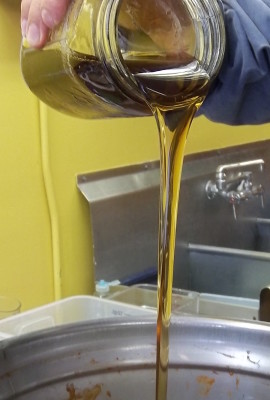
We use organic raw blue agave syrup from GloryBee to add a touch of sweetness and agave flavor to Chicaoji. The light agave nectar sweetens the raw cacao nibs, providing a subtle “chocolaty” taste that is a key component of Chicaoji’s greatness. Indulge your love of sweet things without the sugar by flavoring your foods with Chicaoji, and create your own sweet recipes with blue agave nectar from GloryBee retail website.
Author: Alia O’Connell
I want to thank Alia for composing this blog article. I very much enjoy her style of writing. She does a great job of ordering my jumbled thoughts and ideas.
Alia can help with your need for well-composed English for your blog, website content or term paper.
Contact Alia O’Connell at <aliaoconnell@nullyahoo.com>
Enjoy your Chicaoji!!
Randall Waugh
What began as a simple friendship between cacao nibs and goji berries became something extraordinary when smoky chipotles stepped onto the scene. Chicaoji certainly wouldn’t have become the chief condiment in the cabinet without the spicy heat provided by its boldest ingredient. As the only part of Chicaoji that cannot be considered totally raw, smoky chipotles bring the zing and carry the fire.
Many people don’t know that chipotles are actually ripened jalapeño peppers that have been dried over wood smoke. If jalapeños are allowed to mature, their well-known green coloring gives way to a deep red. The Aztecs in Mexico smoke dried these red peppers as a way of preserving them before the advent of refrigeration. Necessity birthed delicious invention, and smoky chipotles have remained a staple in Mexican and Mexican-inspired cuisine.
The smoky chipotles that we use in Chicaoji are sourced from Mycological Natural Products in Eugene, Oregon. When the naturally preserved peppers arrive at Chicaoji Central, we harness their fiery temperament to create a medium spiciness that can be enjoyed by many. With a noticeable heat that’s not too overwhelming, the smoky chipotles won’t steal the show from the other flavors in Chicaoji.
Like every ingredient that goes into Chicaoji, smoky chipotles are there to provide both flavor and nourishment. Of the many nutrients in chipotle peppers, the most notable is capsaicin, the organic chemical that gives jalapeños their spicy flavor. Capsaicin has been found to energize the metabolism, improve blood circulation and help burn calories. Researchers from Nottingham University have even determined that capsaicin triggers cancer cell death without harming healthy cells in the body.
In addition to capsaicin, chipotle peppers are a great source of dietary fiber, vitamins and minerals. Chipotles contain healthy doses of iron, phosphorous, magnesium, potassium and vitamins A, B6, C and K. Incorporate these vitamins and a little capsaicin heat into your diet by flavoring your meals with Chicaoji. You can also add smoky chipotles to your own recipes. Go to Mycological Natural Products for more info.
Author: Alia O’Connell
I want to thank Alia for composing this blog article. I very much enjoy her style of writing. She does a great job of ordering my jumbled thoughts and ideas.
Alia can help with your need for well-composed English for your blog, website content or term paper.
Contact Alia O’Connell at <aliaoconnell@nullyahoo.com>